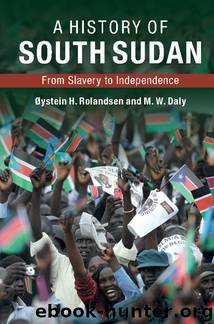A History of South Sudan by Rolandsen Øystein H. & Daly M. W. & Rolandsen Øystein H. & Daly M. W

Author:Rolandsen, Øystein H. & Daly, M. W. & Rolandsen, Øystein H. & Daly, M. W.
Language: eng
Format: epub
Publisher: Cambridge University Press
Published: 2016-05-05T16:00:00+00:00
The end of Abboud and the return of parliamentarian rule
In the face of widespread dissatisfaction, driven in part by the war in the South, the military regime in Khartoum crumbled during the fall of 1964, and on November 14, was forced to resign. A transitional government, based on an alliance of trade unions and northern politicians, was established under Sirr al-Khatim al-Khalifa, a civil servant, as prime minister. The cabinet included Southerners of some political acumen and influence: Ezbon Mundiri (until then serving a prison sentence for subversion), Luigi Adwok, and Clement Mboro, who got the theoretically powerful position of Minister of Interior. All three were associated with the new Southern Front, formed in Khartoum to advocate nonviolence and federation. Abel Alier, at that time a young lawyer and politician, was also among the early members.
By 1964, Greater Khartoum’s many Southern residents, mainly migrants seeking employment and education, were considered locally as a threat to public security. On December 6 – Black Sunday as it would be called – Clement Mboro, having toured the South in his ministerial capacity, was due to return to Khartoum, where a large crowd gathered to greet him. When his plane was delayed, rumors circulated that he had been killed by the government. Riots and looting ensued, and bands of northerners indiscriminately attacked Southerners all over Khartoum. A hundred or more Southerners were killed and many more wounded. Although the political climate was poisoned, the Southern Front continued to collaborate with the transitional government. An important, shared goal was to end the violence in the South. An amnesty was offered to the rebels and politicians in exile, and a Round Table Conference was called.
The goal of the conference, which began in Khartoum on March 16, 1965, was agreement between the northern political establishment and various Southern parties over the future status of the South. Posterity has judged this effort a failure, and in many ways it was. Southern participants were insufficiently united – the new leader of SANU (outside), Aggrey Jaden, attended the opening, read a statement, then left – and the Northern leaders were unwilling to grant the concessions that moderate Southerners demanded. The Conference was important, however, for the precedent it set: for the first time representatives of “Southern Sudan” negotiated with “the north” over constitutional arrangements for the three Southern provinces as one political unit. This innovation, unappreciated at the time, was an early step on the road to the 1972 Peace Agreement and, eventually, Southern secession.
But the Round Table process itself also caused division among Southerners. William Deng, having been marginalized not only within SANU but also in diaspora circles generally, relocated to Khartoum, while the other politicians, despite amnesty, stayed abroad. But Deng fell out too with leaders of the Southern Front, probably over personal rather than political differences and subsequently established SANU “inside” with, among others, Toby Madut, later to be prominent in regional Southern politics.
After elections in March and April 1965, the Umma and NUP formed a coalition government.
Download
This site does not store any files on its server. We only index and link to content provided by other sites. Please contact the content providers to delete copyright contents if any and email us, we'll remove relevant links or contents immediately.
| Africa | Americas |
| Arctic & Antarctica | Asia |
| Australia & Oceania | Europe |
| Middle East | Russia |
| United States | World |
| Ancient Civilizations | Military |
| Historical Study & Educational Resources |
The Travels of Reverend Ólafur Egilsson: The Story of the Barbary Corsair Raid on Iceland in 1627 by Ólafur Egilsson & Karl Smári Hreinsson(592)
Pirates of Barbary: Corsairs, Conquests and Captivity in the Seventeenth-Century Mediterranean by Adrian Tinniswood(526)
Phantom Major by Virginia Cowles(396)
The Iberian World by Fernando Bouza;Pedro Cardim;Antonio Feros;(378)
The Battle for North Africa by Glyn Harper(363)
The Animal in Ottoman Egypt by Alan Mikhail(360)
Roman Legionary vs Carthaginian Warrior by David Campbell(353)
Eritrea at a Crossroads by Andebrhan Welde Giorgis(332)
Collapse of a Country: A Diplomat's Memoir of South Sudan by Nicholas Coghlan(328)
The Barbary Wars by Frank Lambert(327)
The End of Barbary Terror: America's 1815 War against the Pirates of North Africa by Frederick C. Leiner(304)
Christianity in Roman Africa by Burns J. Patout Jr.; Jensen Robin M.; & Robin M. Jensen(302)
The Sands of Kalahari by William Mulvihill(285)
A History of the Mediterranean Air War 1940–1945 by Christopher Shores(278)
Morocco by C. R. Pennell(270)
A Line in the River by Jamal Mahjoub(249)
The Holocaust and North Africa by Aomar Boum Sarah Abrevaya Stein(245)
The Making of a Mediterranean Emirate by Rouighi Ramzi;(244)
A History of South Sudan by Rolandsen Øystein H. & Daly M. W. & Rolandsen Øystein H. & Daly M. W(239)
